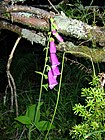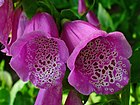Note: This is a project under development. The articles on this wiki are just being initiated and broadly incomplete. You can Help creating new pages.
Difference between revisions of "Digitalis purpurea - Hritpatri"
(→References) |
(→Identification) |
||
| (One intermediate revision by the same user not shown) | |||
| Line 1: | Line 1: | ||
[[File:Digitalis purpurea2.jpg|thumb|right|''Digitalis'', ''Hritpatri'']] | [[File:Digitalis purpurea2.jpg|thumb|right|''Digitalis'', ''Hritpatri'']] | ||
| − | + | '''Hritpatri''' is a genus of about 20 species of herbaceous perennials. This genus was traditionally placed in the figwort family Scrophulariaceae. But recent phylogenetic research has placed it in the much enlarged family Plantaginaceae. This genus is native to western and southwestern Europe, western and central Asia and northwestern Africa. | |
| − | Hritpatri is a genus of about 20 species of herbaceous perennials | ||
== Description == | == Description == | ||
| − | |||
The scientific name means "finger-like" and refers to the ease with which a flower of Digitalis purpurea can be fitted over a human fingertip. The flowers are produced on a tall spike, are tubular, and vary in colour with species, from purple to pink, white, and yellow. The best-known species is the common foxglove, Digitalis purpurea. This biennial plant is often grown as an ornamental plant due to its vivid flowers which range in colour from various purple tints through various shades of light gray, and to purely white. The flowers can also possess various marks and spottings. | The scientific name means "finger-like" and refers to the ease with which a flower of Digitalis purpurea can be fitted over a human fingertip. The flowers are produced on a tall spike, are tubular, and vary in colour with species, from purple to pink, white, and yellow. The best-known species is the common foxglove, Digitalis purpurea. This biennial plant is often grown as an ornamental plant due to its vivid flowers which range in colour from various purple tints through various shades of light gray, and to purely white. The flowers can also possess various marks and spottings. | ||
| Line 42: | Line 40: | ||
==Identification== | ==Identification== | ||
===Leaf=== | ===Leaf=== | ||
| − | {{Leaf|Simple| | + | {{Leaf|Simple|Alternate|The leaves are spirally arranged, simple, 10–35 cm (3.9–13.8 in) long and 5–12 cm (2–5 in) broad, and are covered with gray-white pubescent and glandular hairs, imparting a woolly texture.}}<ref name="Leaf"/> |
===Flower=== | ===Flower=== | ||
| − | {{Flower|Bisexual|Elongated terminal|Violet|2| The flowers are arranged in a showy, terminal, elongated cluster, and each flower is tubular and pendent | + | {{Flower|Bisexual|Elongated terminal|Violet|2| The flowers are arranged in a showy, terminal, elongated cluster, and each flower is tubular and pendent.}} |
===Fruit=== | ===Fruit=== | ||
Latest revision as of 15:40, 27 April 2020
Hritpatri is a genus of about 20 species of herbaceous perennials. This genus was traditionally placed in the figwort family Scrophulariaceae. But recent phylogenetic research has placed it in the much enlarged family Plantaginaceae. This genus is native to western and southwestern Europe, western and central Asia and northwestern Africa.
Contents
Description
The scientific name means "finger-like" and refers to the ease with which a flower of Digitalis purpurea can be fitted over a human fingertip. The flowers are produced on a tall spike, are tubular, and vary in colour with species, from purple to pink, white, and yellow. The best-known species is the common foxglove, Digitalis purpurea. This biennial plant is often grown as an ornamental plant due to its vivid flowers which range in colour from various purple tints through various shades of light gray, and to purely white. The flowers can also possess various marks and spottings.
The term digitalis is also used for drug preparations that contain cardiac glycosides, particularly one called digoxin, extracted from various plants of this genus.
Uses
- A group of medicines extracted from foxglove plants are called digitalin. The use of D. purpurea extract containing cardiac glycosides for the treatment of heart conditions
- It was also approved for the control of ventricular response rate for patients with atrial fibrillation.
- It improves the renal blood flow, it improves the renal filtration and urine formation[1]
Common name
- English - Foxglove
- 'Hindi - Tilpushpi
Properties
Reference: Dravya - Substance, Rasa - Taste, Guna - Qualities, Veerya - Potency, Vipaka - Post-digesion effect, Karma - Pharmacological activity, Prabhava - Therepeutics.
Dravya
Rasa
Tikta (Bitter)
Guna
Laghu (Light), Rooksha (Dry)
Veerya
Sheeta (cold)
Vipaka
Karma
Kapha, Vaata
Prabhava
Habit
Identification
Leaf
| Kind | Shape | Feature |
|---|---|---|
| Simple | Alternate | The leaves are spirally arranged, simple, 10–35 cm (3.9–13.8 in) long and 5–12 cm (2–5 in) broad, and are covered with gray-white pubescent and glandular hairs, imparting a woolly texture. |
Flower
| Type | Size | Color and composition | Stamen | More information |
|---|---|---|---|---|
| Bisexual | Elongated terminal | Violet | 2 | The flowers are arranged in a showy, terminal, elongated cluster, and each flower is tubular and pendent. |
Fruit
| Type | Size | Mass | Appearance | Seeds | More information |
|---|---|---|---|---|---|
| A capsule | {{{5}}} | {{{6}}} |






